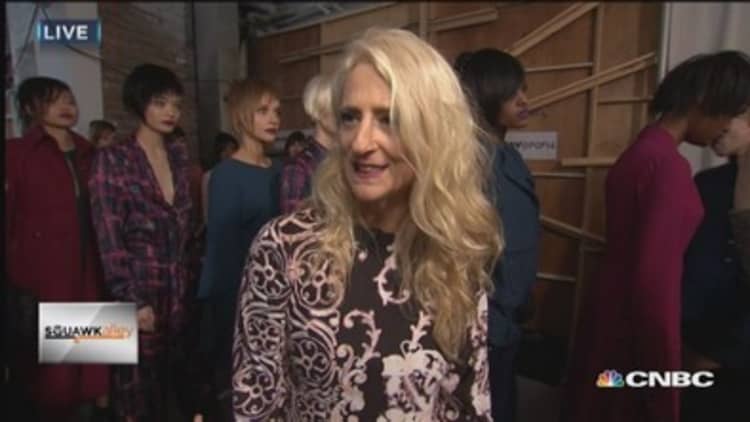
At its core, luxury is a pretty basic concept.
You take a high-quality piece of merchandise, assign it a lofty enough price tag to account for its uniqueness and craftsmanship, and use all those facets to lure wealthy consumers.
These hallmarks have been in play for centuries and remain the key motivators behind the high-end retail market, which accounted for about $390 billion in 2012, according to the Boston Consulting Group.
As timeless as these pillars may be, however, the industry is in the midst of a seismic shift, as younger shoppers, new technology and the desire to spend on high-end experiences are reshaping modern luxury.
Read MoreThe biggest threat to luxury brands' rapid growth
While some brands have been slow to adapt to this sea change, forward-thinking labels and designers have already taken notice, and spoke to the trend at New York Fashion Week.
"Every generation brings its own trend, its own taste, its own way of living," said Jean-Claude Biver, chairman of luxury watchmaker Hublot. "The younger generation is more disruptive."
The power of millennials
According to the Chamber of Commerce, millennials have about $200 billion in direct purchasing power and account for $500 billion more in indirect spending through influencing their parents. By 2017, the generation is expected to outspend the baby boomers, according to a separate study by Berglass + Associates recruiting firm.
The stakes are therefore high for luxury brands, which are hoping establish a connection with young shoppers before they hit their peak spending power. Hublot, whose watches sell for thousands of dollars, is one company that's taken this approach. It recently added 29-year-old model Bar Refaeli to its roster of brand ambassadors to connect with millennials.
Read MoreBuyer beware: What that deal really gets you
Similarly, while Kate Spade has continued courting its older customers by using 93-year-old fashion icon Iris Apfel in its latest advertising campaign, it's also tapped 22-year old model Karlie Kloss.
"It's talking to those girls early and really sort of getting them in and hooking them in with something small that's clever and witty but fits into their lifestyle," the brand's creative director Deborah Lloyd said.
Contemporary designer Rebecca Minkoff, herself a millennial, uses her age to tap into what young shoppers want. That goes not only for her apparel and accessories designs but also for the incorporation of technology into the brand's identity.
At her fall show, for example, Minkoff used a set of GoPro cameras to livestream the runway and backstage chaos to fans. And after opening a high-tech store in Manhattan late last year, the label is also working on new stores in Chicago and LA.
Minkoff said the label's ready-to-wear sales at its futuristic store—which includes smart dressing rooms that suggest complementary pieces—are outpacing those at other locations.
Read MoreWhat not to wear: The most out-of-style fashion stocks
"I'm, I guess, the eldest of the millennials, so I feel like I grew up in that time and I know what she's thinking and I am thinking," Minkoff said. "It's the girl that's going to grow with me but it's also me going, what was I like when I was 20? What did I aspire to own but I couldn't afford?"
Lubov Azria, leader designer at BCBG Max Azria, doesn't have the benefit of tapping into her age to reach younger consumers. She does, however, have five daughters, three of whom are millennials.
"The most important [thing] is to understand that you're not designing for yourself," she said. "You're designing for the customer and understanding their needs."
Aside from being more tech-savvy, millennials are also more willing to experiment with emerging brands, said Andrew Robb, chief operating officer at Farfetch. His company handles the Web operations of 300 high-end boutiques around the globe.
Read MoreThe event that's bigger than the Super Bowl for NYC
"There's this real change happening where people are moving away from just the big magazines dictating a viewpoint," he said in an interview last month, crediting fashion blogs as one of the catalysts. "A lot of the time I'll find customers are shopping with us because they love the fact that these boutiques stock these emerging labels."
Changing definition of luxury
Another big change happening within the industry—partially due to the influence of millennials—is the evolution of the term "luxury."
It no longer refers exclusively to purchases such as handbags or jewelry. Now, it includes higher-price farm-to-table foods and craft beers, as well as pricey experiences such as travel.
Paired with millennials' acceptance of renting instead of owning luxury, made popular by sites such as Rent the Runway, this shift in spending patterns has caused some analysts to view the outlook for traditional luxury brands with a bit of trepidation. BCBG's Azria had a different take.
"When you're traveling, that is the reason why you buy clothes," she said. "So I think actually that stimulates the shopping."
Natural luxury shoppers
Despite their differences, millennials' penchant for discovering new brands, high-quality goods and a company's heritage make them natural luxury consumers, said Matthew Woolsey, executive vice president of digital at Barneys New York.
The key in meeting this list of needs, Biver said, is to stay true the company's DNA, while still pushing the label forward. Hublot does this by embracing its roots as a Swiss watch company, while continuing to modernize its designs for a new wave of customers, he said.
"The heritage of Ferrari cars … is huge," he said. "But they don't make old cars."


